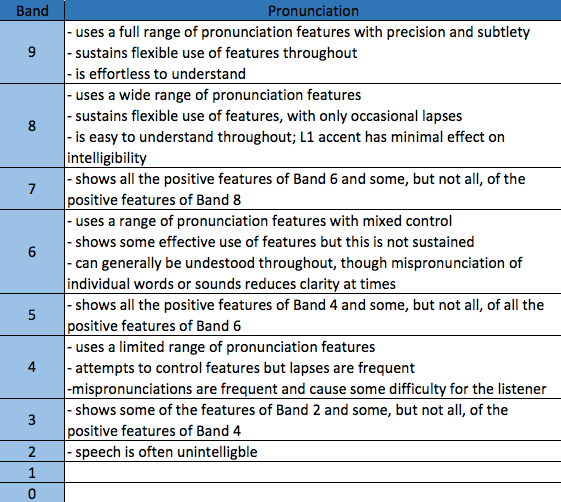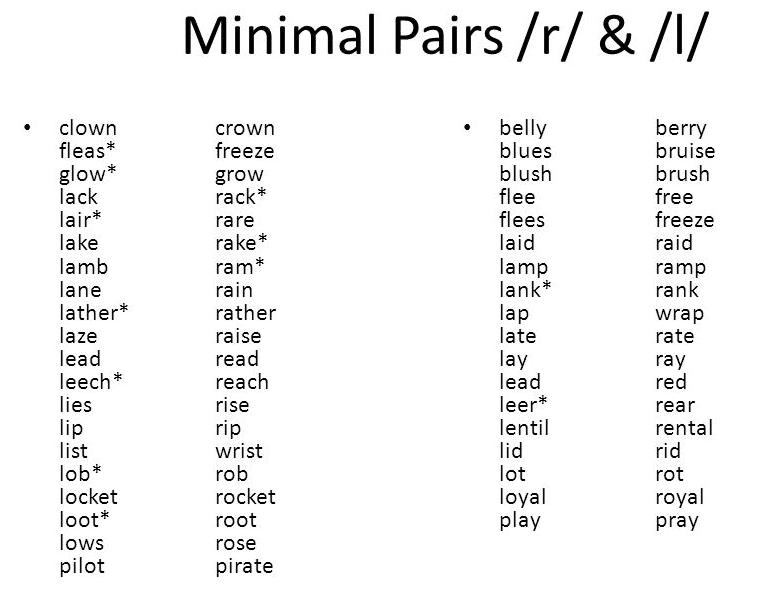How important is your pronunciation in the IELTS Speaking test? You may be surprised to learn that there is actually a quantifiable answer here! Specifically, your pronunciation represents exactly 25% of your potential speaking score, as do three other markable skills: fluency and coherence, lexical resource, and grammatical range and accuracy. (Learn more about how the IELTS speaking test is marked here.)
Keep reading to learn more about how your pronunciation factors into your speaking score and how you can work on improving troublesome features of English.
How is my pronunciation in the IELTS speaking test marked?
Your speaking score will be the average of four scores, each consisting of a number between 0-9. These represent a “band” that describes your skill level. You would earn a zero if you didn’t speak. It seems silly to mention this, but that means that if you take the speaking test, your score would technically fall between 1 (if you are completely unintelligible) and 9 (if your pronunciation is excellent).
So, what makes pronunciation excellent? The key factor here is intelligibility. If your pronunciation interferes with the examiner’s ability to understand you, then you will receive a less-than-perfect score. Ideally, it should require no (or minimal) effort for your listener to understand what you’re trying to say.
Check out the band descriptor for the possible scores you could receive below. You’ll see that if your pronunciation is less than perfect (and by this I mean less than perfectly comprehensible) you can still receive a relatively high score.
As far as your overall speaking score is concerned, there is great news for those who feel less confident in this area. Since there are three other skill areas marked, you may make up for a lower pronunciation score and bring your average up if, say, you’ve got great command of the grammar and an ability to speak smoothly and fluently. If there is a break in communication because of your pronunciation, you can make yourself clear by rewording something the examiner didn’t understand.
How can I work on my pronunciation?
Correctly pronouncing some sounds of the English language can be challenging for two main reasons:
- It’s not a part of the sound system of your native language.
For example, the two variations of “th” (as in the and think) are linguistically rare sounds. Its absence in many world languages makes its pronunciation challenging for speakers of all levels of English. Speakers usually cope with this by replacing it with other sounds (f, v, s, z, d, etc.) Although it is un-native-like, this often does not interfere with comprehension. It only becomes problematic when it makes you difficult to understand. Worry about mastering this sound or its variants only if it makes it hard for others to understand you.
- They’re present in your native language, but they function differently in English.
If you speak one of the languages that can use ‘r’ and ‘l’ interchangeably, you may struggle adapting to the English system where these two sounds are distinct and can change the meaning of a word. Such differences are dreadfully important – consider the difference in meaning between pairs of words like “fly and fry” or “play and pray.” Mixing these up can confuse your conversational partners, so it’s important to master these sounds.
If you have the opportunity to practice speaking with native speakers, try to take note of instances when your conversational partner expresses doubt or confusion about what you said. Which sound was it? Did you notice a pattern in which sounds made it difficult to understand you? If so – use this as evidence to guide your pronunciation practice.
Don’t have a conversational parter? Try a quick online search using the search words: “difficult sounds of English for ______ speakers,” and fill in your native language. Doing this, I quickly found helpful sites that point out which sounds you might need to focus on for native speakers of Russian, French, Spanish, and Mandarin.
Once you’ve identified your problem areas, learn about how to produce the sound and practice! Youtube has amazing videos that are short and sound-specific. You can sometimes watch the shape the mouth makes, listen to someone describe where to put your tongue, whether or not to use your voice box, and other details that native speakers often aren’t aware of, but use everyday! Here, for example, is a five minute video on the two th sounds: How to Pronounce TH Consonants
If you’re having the kind of trouble described in point 2 above, there is a great tool called “minimal pairs lists.” You can use them to practice purposefully pronouncing ‘r’ and ‘l’ and associating them with the correct meaning. Here’s an example of one I found online: Minimal Pairs List: R & L
Read this Magoosh article on improving your English pronunciation and check out these helpful videos for more tips from experts:
- 8 Tips for British English Pronunciation
- English Pronunciation: Bad /æ/ vs Bed /e/
- The Secret to Improve American English Pronunciation
- Tongue Twisters to Improve your English








Leave a Reply